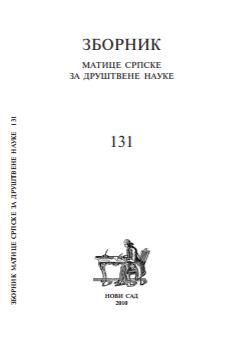ЕТНИЧКИ МИЈЕШАНИ БРАКОВИ НА ПРОСТОРУ БИВШЕ ЈУГОСЛАВИЈЕ, 1970—2005. ГОДИНА
ETHNICALLY MIXED MARRIAGES IN THE AREA OF THE FORMER YUGOSLAVIA (1970—2005)
Author(s): Snježana MrđenSubject(s): Family and social welfare, Demography and human biology, Post-War period (1950 - 1989), Transformation Period (1990 - 2010), Inter-Ethnic Relations
Published by: Матица српска
Keywords: ethnically mixed marriages; former Yugoslavia; exogamy; segregation; nationality;
Summary/Abstract: Analysis of ethnically mixed marriages in the Former Yugoslavia, for the period 1970—2005, shows that after 1990 in all former Yugoslav republics and provinces (except Montenegro) degradation of inter-ethnical relationships induced a fall of inter-ethnical relations, especially at the beginning of 1990. Vojvodina is still singled out (even if there is a decreasing trend after 1990) as a territory with the highest share of exogam marriages (around 25%), while Kosovo and Metohia represent a territory with the lowest shares during the entire period of observation. The most exceptional changes after 1990 occurred in Croatia where the share of ethnically mixed marriages decreased from 19% to around 7% which was mostly a reflection of changes in behaviour of the majority group towards ethnically mixed marriages. The group that was most „open" on the territory of the Former Yugoslavia were the Serbs in Vojvodina until 2001 and after that the Montenegrins, with the highest percentage of interethnic marriages (more than 15%) while all other majority groups are characterized by certain reticence in marrying other nationalities. Concerning the differences between men and women towards ethnically mixed marriages, it shaws that women are, in general, more endogam than men, meaning that they seldom marry outside their group. This is especially characteristic for the Montenegrin's women in Montenegro. When observing the degree of interethnic relations between minority groups and the majority group, it follows that there have not been any changes. In general, degree of integration is higher, meaning that the inter-ethnic relations are more frequent between nationalities that are closer in cultural, religious and linguistic way. Unlike that, during all the period of observation, there is a highly marked segregation between nationalities that belong to different cultural and religious circles, which is especially emphasised in Macedonia.
Journal: Зборник Матице српске за друштвене науке
- Issue Year: 2010
- Issue No: 131
- Page Range: 255-267
- Page Count: 13
- Language: Serbian

